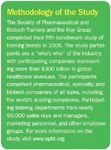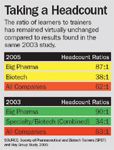Flying Under the Radar
Former GE CEO Jack Welch's no frills-and sometimes cutthroat-approach to business helped him make General Electric a $400-billion company by the end of his tenure in 2001. Though criticized for his desire to make GE a more competitive company, Welch is probably most admired for his leadership style. The CEO enjoyed tailored suits, private jets, and an eight-figure salary per year, but that didn't stop him from sitting face-to-face with a team of 15, 150, or 1,500 employees to talk about what they needed to do to make GE a better company. He knew the value of his team and customers, and he knew that strong leadership made for strong employees.
Former GE CEO Jack Welch's no frills—and sometimes cutthroat—approach to business helped him make General Electric a $400-billion company by the end of his tenure in 2001. Though criticized for his desire to make GE a more competitive company, Welch is probably most admired for his leadership style. The CEO enjoyed tailored suits, private jets, and an eight-figure salary per year, but that didn't stop him from sitting face-to-face with a team of 15, 150, or 1,500 employees to talk about what they needed to do to make GE a better company. He knew the value of his team and customers, and he knew that strong leadership made for strong employees.

The growing complexity of the healthcare environment demands salespeople who better understand customer needs. In turn, the industry also demands highly trained managers who understand the needs of their workforce. Amid a greater segmentation in the marketplace that requires salespeople who have more specialized knowledge about their products and customers, it's now more important than ever to concentrate on providing proper attention to the regional managers (RMs) and directors (RDs), a group that companies sometimes neglect. Without great leaders, pharma companies cannot have great sales reps.
For training executives, these challenges mean that pharma's sales organizations need better, and more exacting, training. To uncover the areas of the biggest need, the Society of Pharmaceutical and Biotech Trainers (SPBT) and the Hay Group conducted a study of more than 100 pharma, biotech, and medical device companies in May and June 2005, representing more than $300 billion in global health revenue and training nearly 90,000 pharma employees (see "Methodology of Study").

Methodology of the Study
This article looks at some of the key trends in learning and development (L&D), including more formalized regional director training and the use of technology. It also suggests how training departments are adapting to the current challenges and rethinking their role—now and for the future.
"RM" Is For Role Model
According to the industry's training heads, the scope of L&D departments continues to expand. Take, for example, one marked reversal of tradition concerning regional director development. Companies now offer—or plan to offer—more formalized training development programs for regional directors or regional managers.
"We are doing three or four times as much training for RSDs [regional sales directors] as we have in the past, or that I have seen at other companies," says Steven Rauschkolb, associate vice president, leadership and management development, at Sanofi-Aventis. "We are covering a wide array of topics, including a thorough review of our core management practices, business acumen, understanding customer needs, strategic thinking, and the ability to deploy resources strategically."

Eric Otterbein Director of field sales management development, TAP Pharmaceuticals
While many companies have had formal training programs in place for reps and district managers for several years, RMs and RDs have flown under the radar. Why? The SPBT and Hay Group study found that these tenured, well-compensated managers are expected to know the business before they get promoted. Still, that doesn't mean RMs and RDs don't need development, says Eric Otterbein, director of field sales management development at TAP Pharmaceuticals. Companies hope the effort results in better retention, improved performance, better overall leadership, and higher sales.
"I think I am speaking for most pharma companies when I say that RMs are the industry's most neglected group when it comes to training," Otterbein says. "Until recently, we just did a lot of on-the-job training, and that was it. But the landscape is changing. Growth is slowing down. People are no longer being promoted to management after just a few years. Now, we have more time on our side. And that's good because the job is becoming more complex."

Steven Rauschkolb Associate vice president, leadership and management development, Sanofi-Aventis
Companies are creating programs to meet the development needs of its RMs. TAP recently launched its first regional manager curriculum, called Your Leadership Journey. The program includes a few weeks of RM on-boarding—orienting and training those who are new to their role and/or their company—to ease transition periods. During that orientation process, new RMs work closely with their sales director and regional manager trainer.
The role of RMs or RDs vary from company to company, with some strictly focused on management, while others also take on account management for managed care clients. In general, though, the SPBT benchmark study revealed that most companies' initial training programs for RMs are focused on building leadership coaching and counseling skills; managing reps' performance; and learning how to comply with regulations. Large and medium-sized pharma and biotech companies seem to offer the most extensive training for RMs. For the smaller pharma companies, extensive training tends to be less common and less comprehensive, although it does exist and likely will expand over time.
California-based Amgen formalized its on-boarding process for its RSDs last year. For DMs who've been promoted to RSDs, the company now offers an intensive, four-day workshop built around core competencies. The workshop includes four simulations designed to help new RSDs test the key skills they will need in their new position.
"Training RSDs is one of our most important priorities," says John Nasser, senior director of global commercial operations, training and development for Amgen. "They represent the front line to our customers and must be well-versed on industry knowledge, business acumen, and managing a multifunctional team."
In addition, Amgen uses the RSD position as a way to develop in-house talent by giving rising stars a shot at managing other managers. The company offers a weeklong leadership development program that engages potential leaders in real-life case studies and team-based challenges.
However, in terms of succession planning, formal development programs for high potential leaders are not as prevalent as one might expect. There has been little increase in the percentage of companies offering formal programs in recent years (see "A Need to Succeed").

A Need to Succeed
Technology: Carrot or Stick?
Technology has continued to reshape how L&D departments deliver training. Over the years, Big Pharma has invested in learning management systems (LMS), which often are used to track course completion, house a virtual course library, perform compliance assessments, and facilitate e-learning enrollment. Some companies also are exploring the next step, which means integrating their existing LMS with learning content management systems (LCMS). LCMS allow content to be recycled so trainers can search their databases of existing training courses for content they can use to customize new modules.
"A lot of companies are looking very carefully now at expenditures for large libraries of generic training," says Rauschkolb. "Experience has shown us that without significant internal marketing of those resources, it is very hard to get the return on investment that training departments are looking for."
In particular, companies wrestle with the delicate issue of when training should take place: on selling time, or on the rep's or manager's own time. Companies that preach the importance of work-life balance can struggle with this issue, Rauschkolb says. "While it is always important to maximize field time, we want people to approach training as an activity that the company endorses because they know that it ultimately will help drive business results, rather than just another chore." What's the solution? "The key to making technology-based training successful might be to give salespeople permission to do it for 30 minutes at the beginning or end of the day," Rauschkolb says. "But this requires a change in mindset."
Companies also may take into consideration what reps like to do. "Salespeople are very gregarious by nature, and they like to get with other salespeople," says Otterbein. "DMs and RMs are the same way. They get a lot of energy and ideas from their peers when in the classroom. If given the choice of a one-day, Web-based course or a three-day classroom course, they will pick the classroom every time." In other words, the aphorism "build it, and they will come" doesn't apply to e-learning.
Companies like Amgen also are investing in technology and tools that managers can use to track reps' development and assist them with coaching. Managers don't like ubiquitous training binders or complex computer programs. Amgen's online tool will be designed to make it easier for managers to set expectations, reinforce learning, perform ongoing coaching, and recognize reps for their efforts. According to the study, other companies are making similar investments in these tools (see "Intellectual Integration").

Intellectual Integration
Mixed Messages for Headcount
While most L&D departments continue to spend the majority of their time focused on sales force activities, trainers also partner with legal, marketing, and HR departments to deliver compliance and product manager training, and other courses.
"If you were in pharma training 10 years ago, tied into a therapeutic team, and as long as you had the sales message down and solid presentation skills, you were in pretty good shape," says Mani Chidambaram, director of learning and development at Esprit Pharma. "Now, our responsibilities have broadened ten-fold. But this is a positive thing. For those of us in training who want to do bigger and better things in our organizations, our training role gives us a much broader range of experience than we might get in the field."
According to the SPBT benchmark study, the ratio of learners to trainers is virtually unchanged compared with the same study they did in 2003 (see "Taking a Headcount"). There are currently an average of 62 salespeople for every in-house trainer. This ratio, though, differs by company size and type. There are generally more salespeople per trainer at Big Pharma (87 to 1) than at biotech companies (38 to 1).

Taking a Headcount
The industry is adding more trainers to the mix for several reasons. There are more reps to be trained; there is a desire to improve the learner-to-trainer ratio; and there is a desire to improve the learner-to-trainer ratio. Overall, 41 percent of the survey respondents reported that their pharma company had plans to grow.
But the survey reveals that not all companies will continue with this trend. Twenty-five percent of the companies surveyed reported plans to scale down as a result of budget cuts and sales force downsizing. In addition to these changes, there is a trend toward re-allocation of training resources. Some large organizations have shifted from a primary care to a specialty sales focus. These companies already have re-allocated their primary care trainers to other responsibilities, like specialty sales or managed care training.
In small and mid-sized companies, training departments are also growing. This includes small companies, such as Esprit Pharma, which maintains two trainers for their 177-rep specialty sales force. But Esprit has plans to grow.
The Value Proposition
In the coming years, trainers predict that their responsibilities will continue to grow, which brings more opportunities for L&D departments to demonstrate their value. They will work with legal and sales to keep the field current on increasingly complex regulatory issues. And, they will need to do it better than their competition.
The training outfit at Amgen, for example, stays connected to the big picture by asking its customers to spell out their business goals every September. "As we build our strategy for the upcoming year, we ask our customers to tell us their goals and business drivers," Nasser says. "We then link our training strategy directly to the behaviors needed to drive business results." By connecting L&D to business results, training stays relevant to senior leadership.
"Today, heads of training increasingly are being challenged to communicate and demonstrate the value of their function throughout the organization," says Brian Fagan, executive director of SPBT. "The key challenges for learning and development departments are visibility in the organization, better integration with other functions, and a stronger role in the overall business strategy of the company."
Michele Goldberg is a senior consultant with Hay Insight and can be reached at michele_goldberg@haygroup.comLaura Ramos is editor of SPBT Focus magazine. She can be reached at lramos@spbt.org
Addressing Disparities in Psoriasis Trials: Takeda's Strategies for Inclusivity in Clinical Research
April 14th 2025LaShell Robinson, Head of Global Feasibility and Trial Equity at Takeda, speaks about the company's strategies to engage patients in underrepresented populations in its phase III psoriasis trials.
Beyond the Prescription: Pharma's Role in Digital Health Conversations
April 1st 2025Join us for an insightful conversation with Jennifer Harakal, Head of Regulatory Affairs at Canopy Life Sciences, as we unpack the evolving intersection of social media and healthcare decisions. Discover how pharmaceutical companies can navigate regulatory challenges while meaningfully engaging with consumers in digital spaces. Jennifer shares expert strategies for responsible marketing, working with influencers, and creating educational content that bridges the gap between patients and healthcare providers. A must-listen for pharma marketers looking to build trust and compliance in today's social media landscape.
